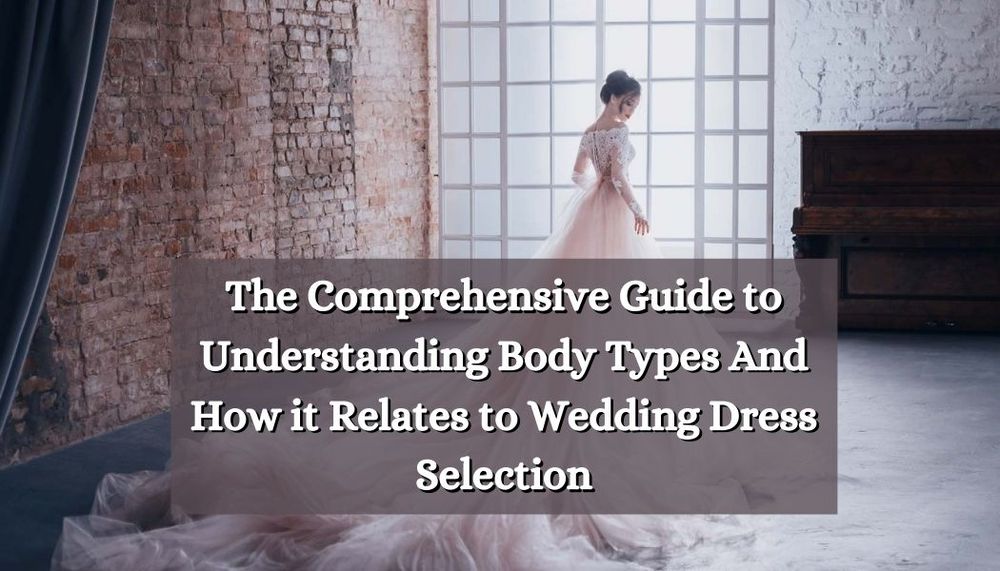
Table of Contents
Why is it Important to Identify Your Body Type Before You Shop For Your Wedding Dress?
Does the very thought of wedding dress shopping make you nervous?
As exciting as bridal dress shopping is, many brides dread the idea of choosing the wrong dress for their special day. This can be an expensive and often, irreversible mistake.
Now, here’s the good news! You can avoid such a mistake.
Wedding dress shopping isn’t complicated if you understand certain fundamental concepts about dress selection. And this is what we will explore in detail.
First, I’ll describe the exact step-by-step procedure to identify your body type since this factor has great significance in your wedding dress selection.
After that, I’ll help you identify the best wedding dress choices based on your findings. Keep reading to find out more.
How to Identify Your Body Type

One of the first and most important factors to consider when selecting any dress (not just wedding dresses) is identifying your body type.
Yes, this is important because dressing right is about celebrating your best features and hiding (or diverting attention from) the less desirable ones.
If you search online, you will find tons of articles describing different ways to identify your body type. Most of these work with three measurements: the bust, waist and hips. However, wedding dresses are more fitted than regular garments. So, you will require one more measurement, and that is your shoulders.
We will follow the Bayou equation when determining your actual body type, where the shoulder and bust measurements can be used interchangeably. Again, this is because not all women are alike.
So, if you have a particularly big or small bust or broad/narrow shoulders, you may fall into two categories instead of just one. In such a case, you should ideally explore suitable options for both body types and find dresses that suit you best.
Let us get on with the actual measurement procedure.
How to Accurately Measure Yourself to Find Your Body Type
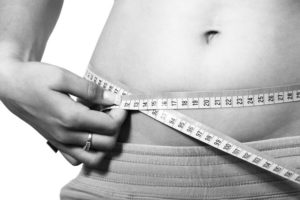
You will be taking your measurements standing upright. Here is what you will need for it:
- An accurate tape measure and notepad for the reading
- A calculator
- Comfortable fitting clothes
- A helping hand (optional)
Although you can do the measurements yourself, the shoulder and bust measurements are usually more accurate when someone else does it for you.
Here is how to carry out each measurement.
Shoulders: It is better to have a friend measure this for you. Your shoulder measurement is the total tape length from one edge of the shoulder all around you to the same point.
Bust: This is the circumference measure across the fullest part of your bust, holding the tape taut but not too tight.
Waist: Locate the narrowest part of your waist. It will usually be just above your belly button. Use a tape measure to go around your body along with this point and note it down.
Hips: This measurement should be taken just below the hip bone. Locate this point and find the circumference of this area.
If you aren’t sure of getting the measurements right, here’s a guide on wikiHow that will help you with detailed instructions and illustrations.
Identifying your body type based on your measurements
Now that you have all your measurements, it is time to use your calculator and do the following Math.
- Shoulders or bust / hips
- Waist / shoulders or bust
- Hips / shoulders or bust
- Waist / Hips
Once you have these numbers figured out, you can use them to identify your body type from the four different standard types, which are:
- Apple or Inverted Triangle
- Rectangle or straight body type
- Pear or Triangle
- Hourglass
These are based on Bradley Bayou’s technique, as outlined in his book, “The science of sexy.”
You can also find detailed explanations for these calculations here on the Oprah website.
Now, let us look at correlating the numbers you just figured out to the corresponding body type.
Different body types and their characteristic features
To discover your body type, you will need the numbers you just measured and those you previously calculated. They were:
- Shoulders
- Bust
- Waist
- Hips
And the ratios of
- Shoulders or bust / hips
- Waist / shoulders or bust
- Hips / shoulders or bust
- Waist / Hips
Read on to understand the four different body types and determine which of these you identify with best.
Apple or Inverted Triangle
If you are an inverted triangle, the ratio of (Shoulders or bust/hips) will be greater than or equal to 1.05.
This means that your shoulder or bust measurement will be greater than your hip measurement by 5%.
Defining characteristic: your shoulders or bust will be larger than your hips.
Rectangle or banana
Pay attention to the ratio of (waist/shoulders or bust). If you are a rectangle, this ratio will be greater than or equal to 0.75.
If this is the case, next look at your bust and hip measurements. They should be within 5% of each other. To establish this, take the largest of your three sizes and multiply it by 0.95. Then multiply the remaining two measurements. If the result is greater than the (largest measurement x 0.95), you are a rectangle.
Defining characteristic: Your shoulders, hips and bust are similar in size.
Pear or Triangle
If you are a triangle, the ratio of (Hips / Shoulders or bust) will be greater than or equal to 1.05
In other words, your hips will measure at least 5% more than your shoulders or bust.
Defining characteristic: Your hips are broader than your shoulders
Hour glass
There are three factors to satisfy if you are an hourglass
Firstly, the ratio of (waist/hips) should be Less than or equal to 0.75
Next, the ratio of (Waist / Shoulders or bust) is less than 0.75
And finally, your shoulder and hip measurements will not differ by more than 5%.
Defining Characteristic: Your upper and lower halves are well-balanced, with a well-defined waistline.
So, we have now understood how to identify each body type using different measurements and calculations. We also analyzed the defining characteristics of all four body types.
Let us now look at the desirable features and the less favourable aspects of different body types.
Desirable features and less favorable aspects of different body types—what to highlight and hide
Even before you identified your body type with the help of this guide, haven’t you felt that certain dress styles look better on you than others?
This is because each body shape has certain desirable features and some less flattering ones. Different dress styles draw attention to various aspects that work in favour of certain body types.
So, let us start.
Apple or Inverted triangle.
Best features: Your curves, slim legs and total bust
Less desirable feature: Thick waistline and narrow hips
When choosing a wedding dress, you should create a curvy look by adding definition to your core. Styles that flare out at the hips, concealing its narrow dimensions, will balance both halves of your body. Also, look for designs that add volume and curves to the lower half, thus toning down the dimensions of the top half.
Rectangle or Banana
Best features: Smaller bust
Less desirable features: Lack of curves and undefined waistline
Silhouettes that create the illusion of curves where there aren’t any are the best choice for this body type. Skirts with added texture or elements like ruffles and bows that add volume will enhance the dimensions of your hips and create a curvy figure.
Pear or Triangle
Best features: Small bust and a narrow waistline
Less desirable features: Large hips
Keep details in the hip area simple and tone it down with more texture and added volume in the upper half. Dresses that flare from the waistline will conceal and distract from the hips. They will also highlight your upper torso and small bust.
Hour glass
Best features: Balanced upper and lower halves and well-defined waistline
The hourglass is considered the ideal body type as it is naturally balanced and curvy. Close-fitting dress styles that highlight your natural curves are the best choice for this body type. Nevertheless, the hourglass can carry off any dress style easily, and you will have more options to choose from if you are an hourglass than any other body type.
Understanding popular wedding dress silhouettes
By now, you should have successfully identified your body type, and you should also be aware of the best and less desirable features. So, what is next?
Finding the ideal wedding dress silhouettes for your body type.
Well, not just yet.
Before we go there, I think you ought to understand the different types of wedding dress silhouettes currently available. This will help you know what each one looks like and why some are suitable for your body type while others aren’t.
So, here are the top-most and popular wedding dress silhouettes you should be aware of:
A-line
Look at the dress in this image. Do you see how it resembles the shape of an A, with the skirt that flares out from the waistline? Hence the name A-line!
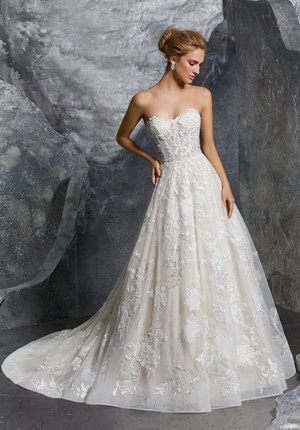
So, this dress style has a bodice that fits closely along the rib cage and then flares out into a smooth A-shape from the waist.
A variation of the A-line called the modified A-line is also gaining popularity among brides. Here is one such gown.
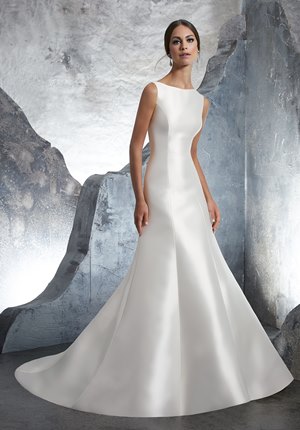
Notice how it is fitted along the bodice and the waistline, all the way down to the hips. Then, it gently flares into an A-line shape from the hips downwards. The benefit of this style is that it is roomier around the hips. Although the simple A-line silhouette is a classic, the modified A-line dress has an edgier look and is better suited for a modern touch.
Ballgown
The signature princess style silhouette this style is characterized by its full and voluminous skirt. However, the dress style also features a snug-fitting bodice that offsets the thick skirt. Here is a perfect example.
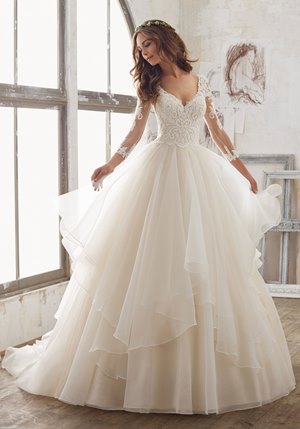
You cannot miss the thick and wide skirt that characterizes this silhouette. It is a very feminine style that is dramatic from every angle. Whether it is the fitted bodice, the ample skirt or the statement train, the ball gown is the silhouette that can stir up quite an impact.
Mermaid
If you wish to show off your natural curves, there couldn’t be a better silhouette to choose from. The mermaid fits all the way snugly from the bodice to the waist and hips, down to the knees. It then flares out beyond the knees, creating a stunning statement. Look at this dress, and you will see what I mean.
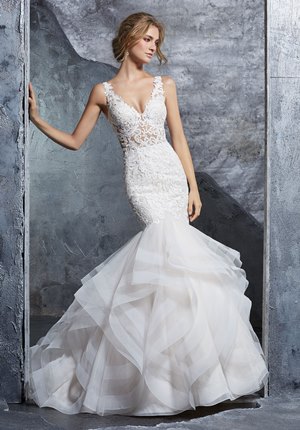
Not only is the silhouette sexy, but it also oozes confidence and style. Not every bride can carry a mermaid-style dress well. So, if you have the body for it, it is a style you shouldn’t overlook.
Trumpet
This silhouette is often confused with the mermaid. However, there are stark differences.
Firstly, the bodice is straight and not snug-fitting like the mermaid. It is also more forgiving than the mermaid since this style flares out from above the knees.
Here is a trumpet-style dress to demonstrate this difference.
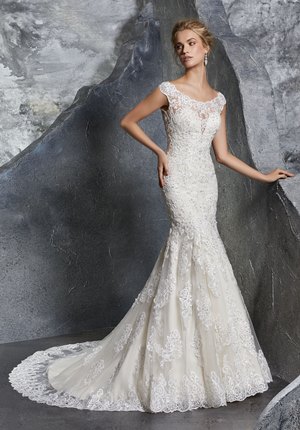
Do you see how the shape closely resembles that of a trumpet? The skirt is also less voluminous compared to the mermaid. Nonetheless, it is a style that allows you to highlight your curves and feminine figure.
Sheath
Just as the name suggests, the sheath is a straight silhouette that falls to full length after skimming the body along its natural curves. The sheath is unusually feminine like you can see in the following image.
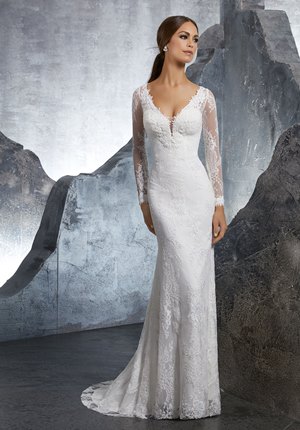
This is because of how it gently hugs the body without being too close-fitted. This creates the illusion of curves, even when there aren’t any. The silhouette also elongates the body, making it appear taller and slimmer.
Empire
This is a unique silhouette that is defined by its raised waistline. Unlike other wedding dress silhouettes, the waistline in an empire dress is higher than the natural waistline. As a result, it appears just under the bust. The following image illustrates how it looks.
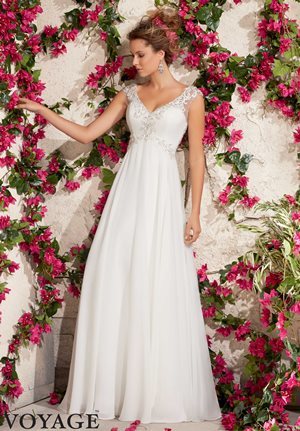
If you look carefully, you will see how the bust has a very distinct demarcation, and the skirt flows into layers right beneath it. It gradually flares away from the body, but the difference is that this happens from right under the bodice. The skirt is loosely draped, while the bodice is well-defined. This style camouflages the waistline and hips and is a very forgiving style that hides the flaws in the lower body.
Dropped waist
Just like the name suggests, this dress silhouette has its waistline lower than the natural waistline. So, the bodice continues down to below the waist and slowly flares into a skirt that flows to full length. So, for instance, check out this dress.
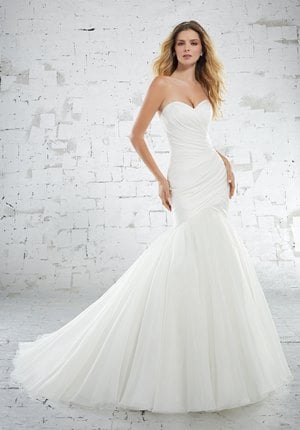
This is a popular dropped waist design, where the draped bodice continues down the waistline to near the hips, where it then flares out into a full skirt. The dropped waistline detail is emphasized with the draping pattern of the dress. The style elongates the torso, making you appear slimmer in the upper body and adding more volume to the lower half beyond the hips.
That brings us to the end of the most popular wedding dress silhouettes that you will come across. Now, let’s move on to the fun part—identifying the best wedding dress silhouettes for each body type!
Remember that there may be more than one silhouette recommended for each body type.
This gives you an excellent variety to choose from. It also means you can have a lot of fun trying dresses of each type during your wedding shopping appointment, till you find your favourite.
Best wedding dress silhouettes for each body type
In the previous chapters, we looked at how to identify the different body types. We also covered the characteristic features of each body type, including desirable ones and those that are best camouflaged.
We also analyzed the most popular wedding dress silhouettes available. It is now time to combine all this information. This will help us to find suitable wedding dress silhouettes for each body type.
Read on to find out the recommended dress styles for each body type, and don’t forget to note what is suitable for you.
Apple or inverted Triangle
The ideal wedding dress will help you flaunt your curves, which is your most vital asset. It will also hide your slight hips and create a curvy look by adding more volume to this area. Here are some suggestions:
Recommended dress silhouettes:
An A-line dress with a thick skirt will look beautiful on you. Aim to find one that nips at the waist and flares out beyond it. This will create the illusion of a slim waistline and highlight a curvy figure.
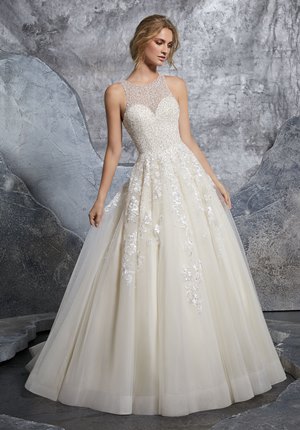
Also, look at ball gowns. The full skirt of this style makes it best for brides with slender hips and legs. They achieve the same effect as an A-line gown, with a slim waistline and thick layers in the skirt that create a curvy figure.
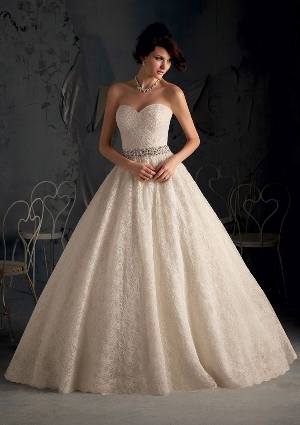
Styles to avoid:
The basic idea is to avoid any dress style that draws attention to your slender lower half or thicker waistline. This would mean dresses like the trumpet and mermaid that fit closely down to the hips.
Rectangle or banana
If your body type is square or rectangle, you will lack a curvy appearance. So, dresses that create the illusion of curves where there aren’t any are the best choices.
Recommended dress silhouettes:
Explore ball gowns since these create a very feminine look with a nipped waistline and thick skirt. This will also draw attention to your small bust while balancing out the overall look with a full skirt.
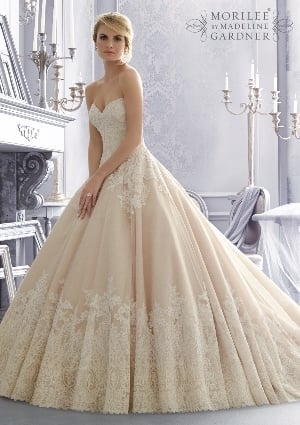
Another dress style that works on straight figures is the sheath. Since the dress loosely drapes along your natural body, it adds the illusion of curves.
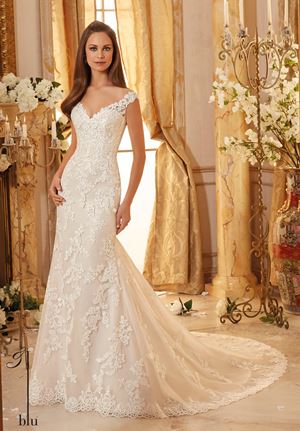
Styles to avoid:
Any dress silhouette that lacks a defined waistline will exaggerate your straight figure. So, avoid styles like the fit and flare, mermaid or dropped waist gowns.
Pear or Triangle
Your best asset is your toned and trims upper body. So, dresses that draw attention to this area and distract from your ample hips will look best. Since you have a small bust, you can also consider dresses with textured and embellished bodices.
Recommended dress silhouettes:
Ball gowns flow away from the waistline, thus camouflaging your large hips. So, this is a great choice to consider.

A similar effect can also be achieved with an A-line dress that flares out from the waist, hiding the area below it under layers of fabric.
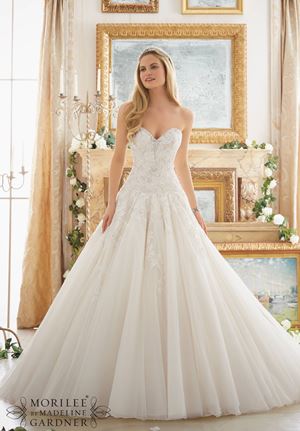
Styles to avoid:
Avoid any style that accentuates the hip or stomach area since these are your less desirable traits. This means that the trumpet is a definite no! Also, avoid the sheath since it adds more volume to the lower half.
Hour glass
If you are an hourglass figure, you are fortunate. Yours is the body type that looks amazing in any and every wedding dress silhouette. Nevertheless, flaunt your beautiful natural curves in dresses that draw attention to your figure. Choose wedding dress silhouettes that will highlight your realistic figure, and you will look stunning. Here are some suggestions.
Recommended dress silhouettes:
Yours is the perfect body type to flaunt fit and flare dress styles like the mermaid and trumpet. Since these silhouettes course snugly along your natural curves and flare out beyond the hips, they will create a dramatic look.
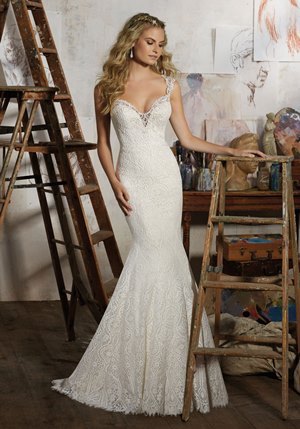
Styles to avoid:
A well-balanced figure like the hourglass will look good in any dress silhouette. So, there are no specific dress styles to avoid. Even so, it is a shame to hide your curvy and sensual figure under dresses that drown you in layers of fabric. So, although you will be able to carry it off, you can do better than choosing an A-line or sheath silhouette.
Wedding dress selection for plus-size and petite brides
Apart from the different body types we discussed earlier, there are two more that we haven’t looked at till now. These are:
Plus-size and petite
This guide would be incomplete unless we discuss wedding dress selection for women who fit this category too. So, let us find out more.
What is plus size and petite?
In the fashion industry, anyone with larger than average proportions is plus-size. So, the typical dress size, in this case, would be 14 or more.
Besides, you can also measure your dress size by putting body dimensions in a free dress size calculator. This is how you can buy the best dress fit according to your body shape.
Petite women, on the other hand, have a small stature and are shorter than average. Their characteristic feature is a well-balanced overall figure but height that is less than 5’3”.
Let us look at the wedding dress selection for both the plus-size and petite bride in detail.
Defining characteristics of plus-size brides
The fit and proportion of plus-size women differ from that of other women, as their curves are more exaggerated. However, most plus-size women are curvy.
Plus-size women also have body types that fit into the five different categories we discussed earlier: triangle, straight, inverted triangle and hourglass. The only difference is that the actual measurements for these women will be larger than the average.
Best wedding dress silhouettes:
The best wedding dress silhouette for your body shape will depend on which body type you resemble closely. Use the guidelines in the previous chapter to determine the best dress silhouettes for your body type.
Nevertheless, a general recommendation is that you choose dresses with good fitting, so it plays up your natural shape.
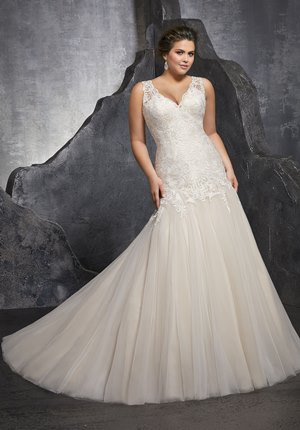
The empire-style and dresses with a well-defined waistline like the A-line or ball gown look amazing on plus-size brides.
Styles to avoid:
Stay away from loosely draped dress silhouettes like the sheath. These only add extra pounds to your look. Also, avoid fabrics that cling and instead opt for structured gowns.
Check out our video below for more help with dress selection when you are plus-size.
Defining characteristics of petite brides
Petite brides are short but with a well-balanced figures. However, their height can make it difficult to find many options in wedding dresses, as the typical wedding dress is designed for women of height 5’5” or more.
Best wedding dress silhouettes:
Any wedding dress style that creates the illusion of extra height by raising the waistline is recommended for petite brides. A-line dresses, trumpets and sheaths also work for this body type since it is well-balanced in both halves.
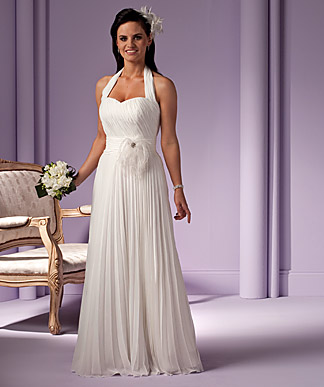
Styles to avoid:
Petite brides will look even shorter in dresses with dropped waists. So, this is a style you shouldn’t wear. Similarly, elaborate silhouettes like the ball gown can overwhelm the smaller size of a petite bride and are best avoided.
Do check the following eHow video for more tips on selecting your wedding dress as a petite bride.
Checklist for understanding your body type and selecting the right wedding dress
Now that we’ve covered the entire scope of this subject, I thought this quick and easy checklist would help you with your wedding dress selection. So, here are the steps to follow.
- Begin by attempting to identify your body type by measuring your
- Shoulders
- Bust
- Waist and
- Hips
- Perform the following calculations
- Shoulders or bust/hips
- Waist/ shoulders or bust
- Hips/ shoulders or bust
- Waist/ hips
- Correlate your measurements with the identified body types:
- Apple or inverted triangle
- Banana or rectangle
- Pear or triangle
- Hourglass
- Plus-size
- Petite
- Cross-check with the suggested dress silhouettes to understand your options
And finally,
- Go wedding dress shopping, armed with this information!
So, that’s it about the different aspects of wedding dress shopping by body type. Didn’t I tell you that it wasn’t complicated if you followed the proper steps?
Now you know all about identifying your body type and choosing the fitting wedding dress silhouettes accordingly. So, please tell me what new features you will be looking for when you go wedding dress shopping by dropping us a comment below are.
For inspiration and a look at the latest trends in wedding dress fashion, visit this link to our bridal dresses. You will find an enormous variety of wedding dresses with all style features and details here. Use it to shortlist your favourites and prepare yourself for when you go shopping.
FAQ – Wedding Gowns
What is the average amount spent on a wedding gown?
While the national average cost of a wedding gown is $1,631 (including modifications), costs vary widely and often range from $500 to $4,000.
How long before the wedding should you purchase your wedding dress?
You should begin the planning process approximately 10 to 12 months prior to your wedding date. The optimal time to shop for a wedding gown is at least eight months before the big day!
Do I have to pay for my wedding gown in full?
When it comes to payment, each salon has its own set of rules, so you’ll need to know when the final amount of your gown is due. Some boutiques ask for full payment up front, while others just want a deposit at the conclusion of your meeting, with the remainder required when your dress comes.
Do you have to wait until you are engaged to go wedding dress shopping?
Yes, it’s tempting to go into a wedding salon and start trying on gowns, especially if you know you’ll be getting married soon. However, we suggest waiting until after the proposal, ideally after you’ve established a date and location.
What are the most common sample sizes in bridal boutiques?
Bridal sizes 10 and 12 are the most frequent sizes sampled, with outliers on each end. Most people can try on these sample sizes, although they rarely fit completely. That’s right; most of our samples will be a bit large or a little tight on you, and that’s entirely normal.
What size wedding gown is considered plus size?
If you generally wear a size 14 or higher, which would be a size 16 in bridal, you are called a plus-size bride. Although most designers cater to plus sizes, many boutiques only have samples in sizes 8, 10, and 12. Before you go shopping, call your local wedding boutique to make sure they can accommodate you.
How does bridal sizing work?
The bridal size differs from that of everyday clothing. If you’re a size 4-6 in jeans, you’re probably a bridal size 8-10, and if you’re a size 14-16, you’re probably a bridal size 18-20. It’s not a big deal–sizing is simply a number!
How many sizes can a dress be altered?
A dress may usually be altered by 1 to 2 sizes. Making a dress smaller is typically simpler than making one larger, although both are possible. It’s generally preferable to take your dress to a professional if you need it modified more than a few sizes.














I’d never heard of the “banana” type body style 🙂
So glad you posted how to find out your body type. All the sites I visited before just show you the photo examples but I kinda fall into a few categories, but now I know for sure I’m actually a pear type.
Knowing your body type is SOOO important for dress shopping… I think some women force themselves into a style just because they like it, but it doesn’t really agree with their specific body type. Your wedding is only once in a lifetime (hopefully) so it’s important to not regret your decision later on!
How important to pick up a wedding dress according to your figure type! My friend, Emily, really wanted a dress with open shoulders. That was definitely not that dress she should have chosen. She’s overweight, has huge shoulders…And in addition to all this, she took a small corset… Sometimes it seemed that her breasts fall out. Terrible! Girls, listen to specialists! It is better to choose what suits you, not what you want.